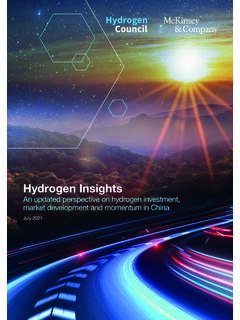Transcription of Hybrid Electrical Vehicles - ae.pwr.wroc.pl
1 Hybrid Electrical Vehicles Introduction A Hybrid electric vehicle (HEV) has two types of energy storage units, electricity and fuel . Electricity means that a battery (sometimes assisted by ultracaps) is used to store the energy, and that an electromotor (from now on called motor) will be used as traction motor. fuel means that a tank is required, and that an Internal Combustion Engine (ICE, from now on called engine) is used to generate mechanical power, or that a fuel cell will be used to convert fuel to Electrical energy. In the latter case, traction will be performed by the electromotor only. In the first case, the vehicle will have both an engine and a motor. Depending on the drive train structure (how motor and engine are connected), we can distinguish between parallel, series or combined HEVs. This will be explained in paragraph 1. Depending on the share of the electromotor to the traction power, we can distinguish between mild or micro Hybrid (start-stop systems), power assist Hybrid , full Hybrid and plug-in Hybrid .
2 This will be explained in paragraph 2. Depending on the nature of the non-electric energy source, we can distinguish between combustion (ICE), fuel cell, hydraulic or pneumatic power, and human power. In the first case, the ICE is a spark ignition engines (gasoline) or compression ignition direct injection (diesel) engine. In the first two cases, the energy conversion unit may be powered by gasoline, methanol , compressed natural gas, hydrogen, or other alternative fuels. Motors are the "work horses" of Hybrid Electric vehicle drive systems. The electric traction motor drives the wheels of the vehicle . Unlike a traditional vehicle , where the engine must "ramp up" before full torque can be provided, an electric motor provides full torque at low speeds. The motor also has low noise and high efficiency. Other characteristics include excellent "off the line" acceleration, good drive control, good fault tolerance and flexibility in relation to voltage fluctuations. The front-running motor technologies for HEV applications include PMSM (permanent magnet synchronous motor), BLDC (brushless DC motor), SRM (switched reluctance motor) and AC induction motor.
3 A main advantage of an electromotor is the possibility to function as generator. In all HEV systems, mechanical braking energy is regenerated. The max. operational braking torque is less than the maximum traction torque; there is always a mechanical braking system integrated in a car. The battery pack in a HEV has a much higher voltage than the SIL automotive 12 Volts battery, in order to reduce the currents and the I2R losses. Accessories such as power steering and air conditioning are powered by electric motors instead of being attached to the combustion engine. This allows efficiency gains as the accessories can run at a constant speed or can be switched off, regardless of how fast the combustion engine is running. Especially in long haul trucks, Electrical power steering saves a lot of energy. 1. Types by drivetrain structure Series Hybrid In a series Hybrid system, the combustion engine drives an electric generator (usually a three-phase alternator plus rectifier) instead of directly driving the wheels.
4 The electric motor is the only means of providing power to the wheels. The generator both charges a battery and powers an electric motor that moves the vehicle . When large amounts of power are required, the motor draws electricity from both the batteries and the generator. Series Hybrid configurations already exist a long time: diesel-electric locomotives, hydraulic earth moving machines, diesel-electric power groups, loaders. Structure of a series Hybrid vehicle (below with flywheel or ultracaps as peak power unit) Series hybrids can be assisted by ultracaps (or a flywheel: KERS=Kinetic Energy Recuperation System), which can improve the efficiency by minimizing the losses in the battery. They deliver peak energy during acceleration and take regenerative energy during braking. Therefore, the ulracaps are kept charged at low speed and almost empty at top speed. Deep cycling of the battery is reduced, the stress factor of the battery is lowered. A complex transmission between motor and wheel is not needed, as electric motors are efficient over a wide speed range.
5 If the motors are attached to the vehicle body, flexible couplings are required. Some vehicle designs have separate electric motors for each wheel. Motor integration into the wheels has the disadvantage that the unsprung mass increases, decreasing ride performance. Advantages of individual wheel motors include simplified traction control (no conventional mechanical transmission elements such as gearbox, transmission shafts, differential), all wheel drive, and allowing lower floors, which is useful for buses. Some 8x8 all-wheel drive military Vehicles use individual wheel motors. A fuel cell Hybrid electric always has a series configuration: the engine-generator combination is replaced by a fuel cell. Structures of a fuel cell Hybrid electric vehicle Weaknesses of series Hybrid Vehicles : The ICE, the generator and the electric motor are dimensioned to handle the full power of the vehicle . Therefore, the total weight, cost and size of the powertrain can be excessive. The power from the combustion engine has to run through both the generator and electric motor.
6 During long-distance highway driving, the total efficiency is inferior to a conventional transmission, due to the several energy conversions. Advantages of series Hybrid Vehicles : There is no mechanical link between the combustion engine and the wheels. The engine-generator group can be located everywhere. There are no conventional mechanical transmission elements (gearbox, transmission shafts). Separate electric wheel motors can be implemented easily. The combustion engine can operate in a narrow rpm range (its most efficient range), even as the car changes speed. Series hybrids are relatively the most efficient during stop-and-go city driving. Example of SHEV: Renault Kangoo. Parallel Hybrid Parallel Hybrid systems have both an internal combustion engine (ICE) and an electric motor in parallel connected to a mechanical transmission. Structure of a parallel Hybrid electric vehicle Most designs combine a large Electrical generator and a motor into one unit, often located between the combustion engine and the transmission, replacing both the conventional starter motor and the alternator (see figures above).
7 The battery can be recharged during regenerative breaking, and during cruising (when the ICE power is higher than the required power for propulsion). As there is a fixed mechanical link between the wheels and the motor (no clutch), the battery cannot be charged when the car isn t moving. When the vehicle is using Electrical traction power only, or during brake while regenerating energy, the ICE is not running (it is disconnected by a clutch) or is not powered (it rotates in an idling manner). 2268x 222668 TxTT Operation modes: The parallel configuration supports diverse operating modes: Some typical modes for a parallel Hybrid configuration PE = Power electronics TX = Transmission (a) electric power only: Up to speeds of usually 40 km/h, the electric motor works with only the energy of the batteries, which are not recharged by the ICE. This is the usual way of operating around the city, as well as in reverse gear, since during reverse gear the speed is limited. (b) ICE power only: At speeds superior to 40 km/h, only the heat engine operates.
8 This is the normal operating way at the road. 3 8 7 2 5 4 1 6 1: fuel tank 2: Engine 3: Wheels 4: Battery 5: Converter 6: Electric Motor 7: Reduction gear 8: Differential (b) ICE + electric power: if more energy is needed (during acceleration or at high speed), the electric motor starts working in parallel to the heat engine, achieving greater power (c) ICE + battery charging: if less power is required, excess of energy is used to charge the batteries. Operating the engine at higher torque than necessary, it runs at a higher efficiency. (d) regenerative breaking: While braking or decelerating, the electric motor takes profit of the kinetic energy of the he moving vehicle to act as a generator. Sometimes, an extra generator is used: then the batteries can be recharged when the vehicle is not driving, the ICE operates disconnected from the transmission. But this system gives an increased weight and price to the HEV. A parallel HEV can have an extra generator for the battery (left) Without generator, the motor will charge the battery (right) Weaknesses of parallel Hybrid Vehicles : Rather complicated system.
9 The ICE doesn t operate in a narrow or constant RPM range, thus efficiency drops at low rotation speed. As the ICE is not decoupled from the wheels, the battery cannot be charged at standstill. Advantages of parallel Hybrid Vehicles : Total efficiency is higher during cruising and long-distance highway driving. Large flexibility to switch between electric and ICE power Compared to series hybrids, the electromotor can be designed less powerful than the ICE, as it is assisting traction. Only one Electrical motor/generator is required. Example of PHEV: Honda Civic. Honda's IMA (Integrated Motor Assist) uses a rather traditional ICE with continuously variable transmission, where the flywheel is replaced with an electric motor. Influence of scale: a Volvo 26 ton truck (12 ton own weight, 14 ton max load) equipped with 200 kg of batteries can drive on pure electric power for 2 minutes only! Because of space constraints, it is not possible to build in more batteries. BMW 7 Series ActiveHybrid.
10 Combined Hybrid Combined Hybrid systems have features of both series and parallel hybrids. There is a double connection between the engine and the drive axle: mechanical and Electrical . This split power path allows interconnecting mechanical and Electrical power, at some cost in complexity. Power-split devices are incorporated in the powertrain. The power to the wheels can be either mechanical or Electrical or both. This is also the case in parallel hybrids. But the main principle behind the combined system is the decoupling of the power supplied by the engine from the power demanded by the driver. Simplified structure of a combined Hybrid electric vehicle In a conventional vehicle , a larger engine is used to provide acceleration from standstill than one needed for steady speed cruising. This is because a combustion engine's torque is minimal at lower RPMs, as the engine is its own air pump. On the other hand, an electric motor exhibits maximum torque at stall and is well suited to complement the engine's torque deficiency at low RPMs.

